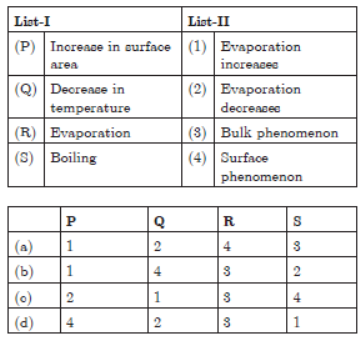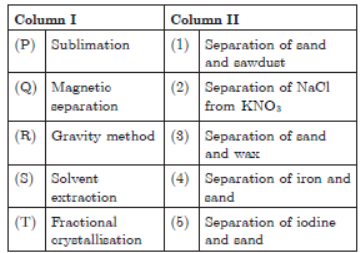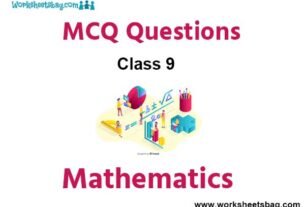Please refer to Matter in Our Surroundings MCQ Questions Class 9 Science below. These MCQ questions for Class 9 Science with answers have been designed as per the latest NCERT, CBSE books, and syllabus issued for the current academic year. These objective questions for Matter in Our Surroundings will help you to prepare for the exams and get more marks.
Matter in Our Surroundings MCQ Questions Class 9 Science
Please see solved MCQ Questions for Matter in Our Surroundings in Class 9 Science. All questions and answers have been prepared by expert faculty of standard 9 based on the latest examination guidelines.
MCQ Questions Class 9 Science Matter in Our Surroundings
OBJECTIVE QUESTIONS
Question. Which of the following is not correct regarding gases?
(a) Gases exert pressure.
(b) Gases have large intermolecular spaces.
(c) Gases have weak tendency to diffuse.
(d) Gases have weak intermolecular forces of attraction.
Answer
C
Question. The evaporation of a liquid can be best carried out in a
(a) beaker
(b) China dish
(c) test tube
(d) flask
Answer
B
Question. Which of the following states has the least energetic molecules?
(a) Solids
(b) Liquids
(c) Gases
(d) Plasmas
Answer
A
Question. Which of the following process(es) release(s) heat?
1. Condensation
2. Vaporisation
3. Freezing
4. Melting
(a) Only 1
(b) Only 4
(c) 1 and 3
(d) 2 and 4
Answer
C
Question. Ice floats on the surface of water because:
(a) it is heavier than water
(b) the density of both water and ice is the same
(c) ice is lighter than water
(d) none of these
Answer
C
Question. Kinetic energy of molecules is directly proportional to
(a) temperature
(b) pressure
(c) both (a) and (b)
(d) atmospheric pressure
Answer
A
Question. The electric bulb on long use forms a black coating on its inner surface. The process associated with this is
(a) melting of tungsten
(b) sublimation of tungsten
(c) oxidation of tungsten
(d) reduction of tungsten
Answer
B
Question. If a few spoons of salt are dissolved in pure water then
(a) its b.pt. becomes less than 100cC
(b) its b.pt. becomes more than 100cC
(c) its freezing point becomes more than 0cC
(d) none of these
Answer
B
Question. In which form, do the water molecules have less kinetic energy?
(a) Ice
(b) Water
(c) Steam
(d) All of them have equal kinetic energy
Answer
A
Question. Which of the following describes the liquid phase?
(a) It has a definite shape and a definite volume.
(b) It has a definite shape but not definite volume.
(c) It has a definite volume but not a definite shape.
(d) It has neither a definite shape nor a definite volume.
Answer
C
Question. A gas can be best liquefied
(a) by increasing the temperature
(b) by lowering the pressure
(c) by increasing the pressure and reducing the temperature
(d) none of these
Answer
C
Question. The state of matter which consists of super energetic particles in the form of ionized gases is called
(a) gaseous state
(b) liquid state
(c) Bose-Einstein condensate
(d) plasma state
Answer
D
Question. To separate the solids which are insoluble in liquids such that solid is heavier than liquid:
(a) sedimentation and decantation
(b) evaporation and condensation
(c) filtration
(d) condensation and crystallization
Answer
A
Question. A saturated salt water solution was heated and allowed to cool without adding any more salt. What will happen?
(a) Some salt appears to settle at the bottom.
(b) Some more salt can be dissolved now.
(c) No change takes place.
(d) Both (a) and (b)
Answer
C
Question. In an experiment oxygen was added to hydrogen and heated. On burning a substance containing both oxygen and hydrogen water was formed. What is this substance?
(a) Element
(b) Compound
(c) Solution
(d) Mixture
Answer
B
Question. Evaporation is directly proportional to
1. humidity
2. surface area
3. temperature
4. wind speed
(a) 1 and 4
(b) 2 and 3
(c) 3 and 4
(d) 2, 3 and 4
Answer
D
Question. When liquid starts boiling, further heat energy which is supplied
(a) is lost to the surroundings as much
(b) increases the temperature of the liquid
(c) increases the kinetic energy of the particles in the liquid
(d) is absorbed as latent heat of vaporisation by the liquid.
Answer
D
Question. The forces of attraction between the particles of matter is maximum in
(a) iron rod
(b) kerosene oil
(c) glycerine
(d) dry air
Answer
A
Question. Addition of impurities to water:
(a) decreases the freezing point of water
(b) increases the boiling point of water
(c) does not affect the freezing or boiling point of water
(d) both (a) and (b)
Answer
D
Question. Evaporation of a liquid can take place
(a) at its boiling point
(b) below its boiling point
(c) above its boiling point
(d) at fixed temperature
Answer
B
Question. You can separate a mixture of sand, salt and water by:
(a) filtration and distillation
(b) decantation and evaporation
(c) filtration and decantation
(d) decantation and crystallization
Answer
B
Question. Which of the following statements about evaporation is incorrect?
1. It is bulk phenomena.
2. It is a fast process.
3. It takes place at all temperatures.
(a) 2 and 3
(b) 1 and 2
(c) 1 and 3
(d) 1, 2 and 3
Answer
B
Question. Which of the following pair of gases cannot be separated by diffusion method?
(a) SO2 and H2
(b) CO2 and N2O
(c) NH3 and N2
(d) CO2 and H2
Answer
B
Question. The quantity of matter present in an object is called its
(a) weight
(b) gram
(c) mass
(d) density
Answer
C
Question. Sugar syrup, usually used to coat sweets with sugar, becomes hard when cooled. From this we can conclude that sugar syrup is:
(a) a saturated solution
(b) an unsaturated solution
(c) not a solution
(d) none of these
Answer
A
Question. Alcohol exists as a liquid at room temperature because
(a) the intermolecular forces are strong enough to keep its particles bound to each other
(b) its melting point is below room temperature
(c) it is highly compressible
(d) both (a) and (b)
Answer
D
Question. Which of the following statements is not correct?
(a) Matter is continuous in nature.
(b) Inter-particle spaces are maximum in the gaseous state of a substance.
(c) Particles which constitute the matter follow a zigzag path.
(d) Solid state is the most compact state of a substance.
Answer
C
FILL IN THE BLANK
Question. Compounds are formed by chemically combining elements in a proportion by weight.
Answer
definite
Question. can be classified chemically into pure substance and mixtures.
Answer
Matter
Question. Soda water can be separated by the pressure.
Answer
lowering
Question. During distillation of iodine and methyl alcohol the non-volatile substance is ……….
Answer
iodine
Question. A mixture of barium sulphate and H2O can be separated by the method of ……….
Answer
filtration
Question. The principle of difference in boiling points of liquid is used in the ……….
Answer
fractional distillation
Question. During the separation of CO2 and O2 by the process of preferential liquefaction, the component ………. liquefies.
Answer
CO2
Question. Both elements and compounds are substances.
Answer
pure
TRUE/FALSE
Question. Distilled water cannot be separated into its constituents by physical methods.
Answer
True
Question. Sand and sawdust can be separated by gravity method.
Answer
True
Question. The properties of compounds are same from those of the elements of which they are made.
Answer
False
Question. A handful of soil is homogeneous mixture of solids.
Answer
False
Question. Separation of CCl4 from CS2 can be carried out by separating funnel method.
Answer
False
MATCHING QUESTIONS
Question.

Answer
(a) P – 1, Q – 2, R – 4, S – 3
Question.

Answer
P – 5, Q – 4, R – 1, S – 3, T – 2
Question.

Answer
(a) P – 2, Q – 1, R – 4, S – 3
ASSERTION AND REASON
Question. Assertion : Camphor disappears without leaving any residue.
Reason : Camphor undergoes sublimation.
Options:
(a) Both assertion (A) and reason (R) are true and reason (R) is the correct explanation of assertion (A).
(b) Both assertion (A) and reason (R) are true but reason (R) is not the correct explanation of assertion (A).
(c) Assertion (A) is true but reason (R) is false.
(d) Assertion (A) is false but reason (R) is true.
Answer
A
Question. Assertion : Solids do not diffuse in air.
Reason : The particles are closely packed in solids.
Options:
(a) Both assertion (A) and reason (R) are true and reason (R) is the correct explanation of assertion (A).
(b) Both assertion (A) and reason (R) are true but reason (R) is not the correct explanation of assertion (A).
(c) Assertion (A) is true but reason (R) is false.
(d) Assertion (A) is false but reason (R) is true.
Answer
A
Question. Assertion : The conversion of a gas directly into solid is called condensation.
Reason : Naphthalene leaves residue when kept open for some time.
Options:
(a) Both assertion (A) and reason (R) are true and reason (R) is the correct explanation of assertion (A).
(b) Both assertion (A) and reason (R) are true but reason (R) is not the correct explanation of assertion (A).
(c) Assertion (A) is true but reason (R) is false.
(d) Assertion (A) is false but reason (R) is true.
Question. Assertion : The rate of evaporation increases with increase in temperature.
Reason : Increase in temperature increases the kinetic energy of the particles.
Options:
(a) Both assertion (A) and reason (R) are true and reason (R) is the correct explanation of assertion (A).
(b) Both assertion (A) and reason (R) are true but reason (R) is not the correct explanation of assertion (A).
(c) Assertion (A) is true but reason (R) is false.
(d) Assertion (A) is false but reason (R) is true.
Answer
A
Question. Assertion : The intermolecular forces in solid state are stronger than those in the liquid state.
Reason : The space between the particles of matter is called intermolecular space.
Options:
(a) Both assertion (A) and reason (R) are true and reason (R) is the correct explanation of assertion (A).
(b) Both assertion (A) and reason (R) are true but reason (R) is not the correct explanation of assertion (A).
(c) Assertion (A) is true but reason (R) is false.
(d) Assertion (A) is false but reason (R) is true.
Answer
B
Question. Assertion : A gas can be easily compressed by applying pressure.
Reason : Since the inter-particle spaces in the gaseous state are very small, they cannot be decreased by applying pressure.
Options:
(a) Both assertion (A) and reason (R) are true and reason (R) is the correct explanation of assertion (A).
(b) Both assertion (A) and reason (R) are true but reason (R) is not the correct explanation of assertion (A).
(c) Assertion (A) is true but reason (R) is false.
(d) Assertion (A) is false but reason (R) is true.
Answer
C
Question. Assertion : Ice floats on the surface of water.
Reason : The density of both water and ice is same.
Options:
(a) Both assertion (A) and reason (R) are true and reason (R) is the correct explanation of assertion (A).
(b) Both assertion (A) and reason (R) are true but reason (R) is not the correct explanation of assertion (A).
(c) Assertion (A) is true but reason (R) is false.
(d) Assertion (A) is false but reason (R) is true.
Answer
C
Question. Assertion : Liquids diffuse less easily as compared to gases.
Reason : Intermolecular forces are greater in gases.
Options:
(a) Both assertion (A) and reason (R) are true and reason (R) is the correct explanation of assertion (A).
(b) Both assertion (A) and reason (R) are true but reason (R) is not the correct explanation of assertion (A).
(c) Assertion (A) is true but reason (R) is false.
(d) Assertion (A) is false but reason (R) is true.
Answer
C
Question. Assertion : At normal pressure (1 atm) the boiling point of water is 100cC or 373.15 K.
Reason : As the pressure increases, boiling point of water also increases.
Options:
(a) Both assertion (A) and reason (R) are true and reason (R) is the correct explanation of assertion (A).
(b) Both assertion (A) and reason (R) are true but reason (R) is not the correct explanation of assertion (A).
(c) Assertion (A) is true but reason (R) is false.
(d) Assertion (A) is false but reason (R) is true.
Answer
B
Question. Assertion : During evaporation of liquids, the temperature remains unaffected.
Reason : Kinetic energy of the molecules is inversely proportional to absolute temperature.
Options:
(a) Both assertion (A) and reason (R) are true and reason (R) is the correct explanation of assertion (A).
(b) Both assertion (A) and reason (R) are true but reason (R) is not the correct explanation of assertion (A).
(c) Assertion (A) is true but reason (R) is false.
(d) Assertion (A) is false but reason (R) is true.
Answer
D
